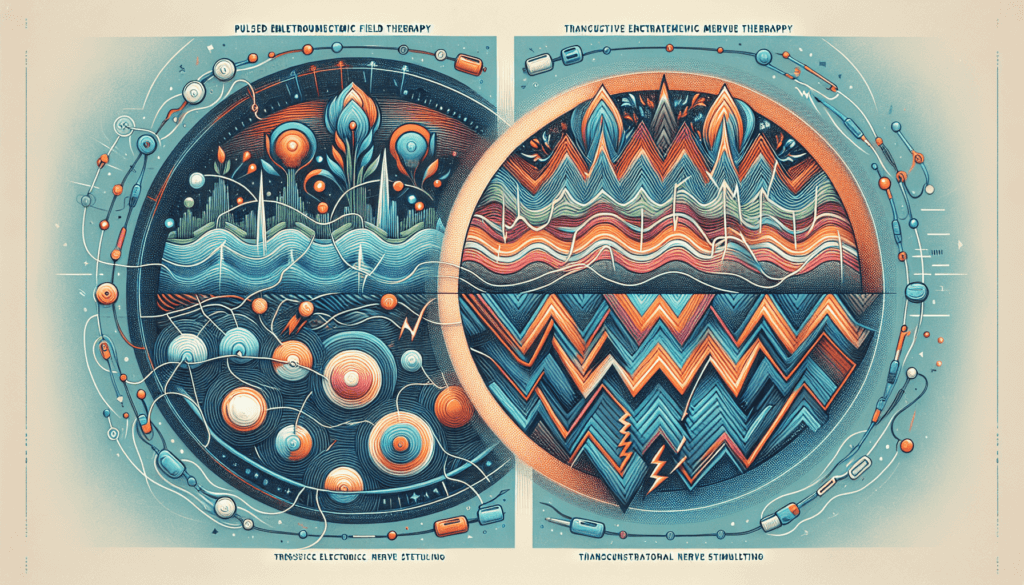Pemf Vs Tens explores the fascinating world of two cutting-edge therapies: Pemf (Pulsed Electromagnetic Field) and Tens (Transcutaneous Electrical Nerve Stimulation). As you embark on this informative journey, you will gain a deeper understanding of how these treatments work, their potential benefits, and the key differences between them. Whether you’re seeking pain relief, improved sleep, or enhanced overall wellness, this article will equip you with the knowledge you need to make an informed decision about which therapy may be best for you.
What is PEMF?
Definition
PEMF stands for Pulsed Electromagnetic Field therapy. It is a non-invasive treatment that uses electromagnetic fields to improve overall health and well-being. PEMF devices emit electromagnetic pulses that stimulate the body’s natural healing processes.
How it works
PEMF works by delivering low-intensity electromagnetic waves to the body. These waves create small electrical currents within the cells, which can enhance cell function and promote healing. The electromagnetic fields can penetrate deep into the body, reaching areas that are often inaccessible through other forms of treatment.
Benefits and uses
PEMF therapy has been found to have a wide range of benefits. It can help alleviate pain, improve sleep, reduce inflammation, enhance circulation, accelerate healing, and promote overall wellness. Additionally, PEMF has been used in the treatment of various conditions, such as arthritis, sports injuries, fibromyalgia, and even depression.
What is TENS?
Definition
TENS, short for Transcutaneous Electrical Nerve Stimulation, is a therapy that uses low-voltage electrical currents to relieve pain. It involves placing electrodes on the skin near the area of pain or discomfort, which then send electrical impulses to the nerves.
How it works
TENS works by stimulating the nerves to block pain signals from reaching the brain. The electrical currents produced by the TENS device interfere with the pain signals, effectively reducing or eliminating the sensation of pain.
Benefits and uses
TENS therapy offers numerous benefits, with pain relief being the primary advantage. It can be used to manage acute and chronic pain, such as back pain, joint pain, and muscle soreness. TENS is also known to improve range of motion, increase blood flow, and relax tense muscles, making it a popular choice for physical therapy and rehabilitation.

Comparison of PEMF and TENS
Mechanism of action
While both PEMF and TENS therapies involve the use of electrical currents, their mechanisms of action differ. PEMF works by delivering electromagnetic pulses that directly influence the body’s cells, whereas TENS works by blocking pain signals through nerve stimulation.
Treatment area
PEMF therapy can be used to target a specific area of the body, but it can also have a systemic effect. TENS, on the other hand, is typically applied directly to the area of pain or discomfort.
Depth of penetration
When it comes to depth of penetration, PEMF has an advantage. Its electromagnetic waves can reach deeper tissues and organs, making it more suitable for conditions that require deep healing. TENS, however, primarily affects superficial nerves and muscles.
Intensity
PEMF therapy typically uses lower-intensity electromagnetic fields, while TENS devices can be adjusted to deliver a range of intensity levels.
Frequency
PEMF devices produce electromagnetic pulses at specific frequencies, often in the range of 1-50 Hz. TENS therapy, on the other hand, operates at higher frequencies, typically between 50-100 Hz.
Treatment duration
The duration of treatment can vary for both PEMF and TENS therapies. PEMF sessions can range from a few minutes to hours, depending on the condition being treated. TENS treatments are often shorter and can be administered for 15-45 minutes at a time.
Side effects
Both PEMF and TENS therapies are generally considered safe and have minimal side effects. However, some individuals may experience skin irritation or mild discomfort at the site of electrode placement during TENS therapy.
Contraindications
There are certain conditions and health factors that may restrict or require caution when using PEMF or TENS therapies. It is important to consult with a healthcare professional before starting either treatment, especially if you have a pacemaker, are pregnant, or have specific medical conditions.
Effectiveness
PEMF and TENS therapies have been found to be effective in managing pain and promoting healing. The effectiveness may vary depending on the individual and the specific condition being treated. It is advisable to consult with a healthcare professional to determine the most suitable therapy for your needs.
Choosing between PEMF and TENS
When deciding between PEMF and TENS therapy, there are several factors to consider:
Goals of treatment
If your primary goal is pain relief, both PEMF and TENS can be effective. However, if you are seeking overall wellness and cellular regeneration, PEMF may be a better option.
Type of condition
Consider the specific condition you are seeking treatment for. For deeper tissue or systemic issues, PEMF may be more appropriate. For localized pain or muscle-related conditions, TENS might be the better choice.
Cost
Take into account the cost of equipment, ongoing maintenance, and potential additional expenses, such as electrode pads. Compare the costs of PEMF and TENS devices to determine which fits your budget better.
Ease of use
Evaluate the ease of use for each therapy. PEMF devices typically require minimal setup and can be used at home. TENS devices may require electrode pad placement and adjustment, which may be more cumbersome for some individuals.
Availability
Consider the availability of the therapy options. PEMF devices can be purchased for home use or accessed through professional clinics. TENS devices are widely available for purchase and can also be obtained through healthcare providers.
Medical advice
Always consult with a healthcare professional before starting any new therapy. They can provide personalized advice based on your specific condition and medical history.

PEMF Devices
Types of PEMF devices
There are various types of PEMF devices available on the market. Some options include full-body mats, localized applicators, handheld devices, and even wearable PEMF devices.
Popular PEMF devices on the market
Some popular PEMF devices include the EarthPulse PEMF sleep system, the PEMF8000 Elite, and the iMRS 2000.
TENS Devices
Types of TENS devices
TENS devices come in different forms, such as handheld units, wearable devices, and even wireless options. They vary in features, intensity settings, and electrode placements.
Popular TENS devices on the market
Some popular TENS devices include the Omron Pocket Pain Pro, the HealthmateForever YK15RC, and the iReliev TENS + EMS system.
Research and Evidence
Clinical studies on PEMF
There is a growing body of clinical studies that support the effectiveness of PEMF therapy. Research has demonstrated its benefits in various conditions, including chronic pain, osteoarthritis, wound healing, and depression.
Clinical studies on TENS
TENS therapy has also been extensively studied, with research showing its efficacy in managing acute and chronic pain, post-operative pain, and musculoskeletal conditions.
Comparative studies
Comparative studies between PEMF and TENS therapies have been conducted, although they are limited. These studies have primarily focused on pain management and found both therapies to be effective. It is important to note that individual responses may vary.
User Experiences and Reviews
PEMF user experiences
Many individuals have reported positive experiences with PEMF therapy. Users have shared stories of reduced pain, improved sleep, enhanced recovery from injuries, and increased overall well-being.
TENS user experiences
TENS therapy has also garnered positive feedback from users. People have reported pain relief, increased mobility, and improved quality of life.
Comparative user reviews
Comparative user reviews on PEMF and TENS therapies can provide valuable insights. Users have praised both treatments for their pain-relieving abilities, with preferences often depending on personal preferences and specific conditions.
Safety Precautions
Guidelines for using PEMF
When using PEMF devices, it is important to follow safety guidelines. These guidelines typically include avoiding use near electronic devices, using appropriate intensity levels, and maintaining proper hygiene when using localized applicators.
Guidelines for using TENS
TENS therapy also requires adherence to safety precautions. These may include avoiding placement over the chest or neck, using appropriate intensity levels, and carefully following the manufacturer’s instructions.
Conclusion
Both PEMF and TENS offer effective non-invasive therapies for pain management and overall well-being. Understanding the differences between the two treatments, along with considering individual needs and preferences, can help in determining which therapy is the most suitable choice. As always, consult with a healthcare professional for personalized advice and guidance on using these therapies effectively and safely.


